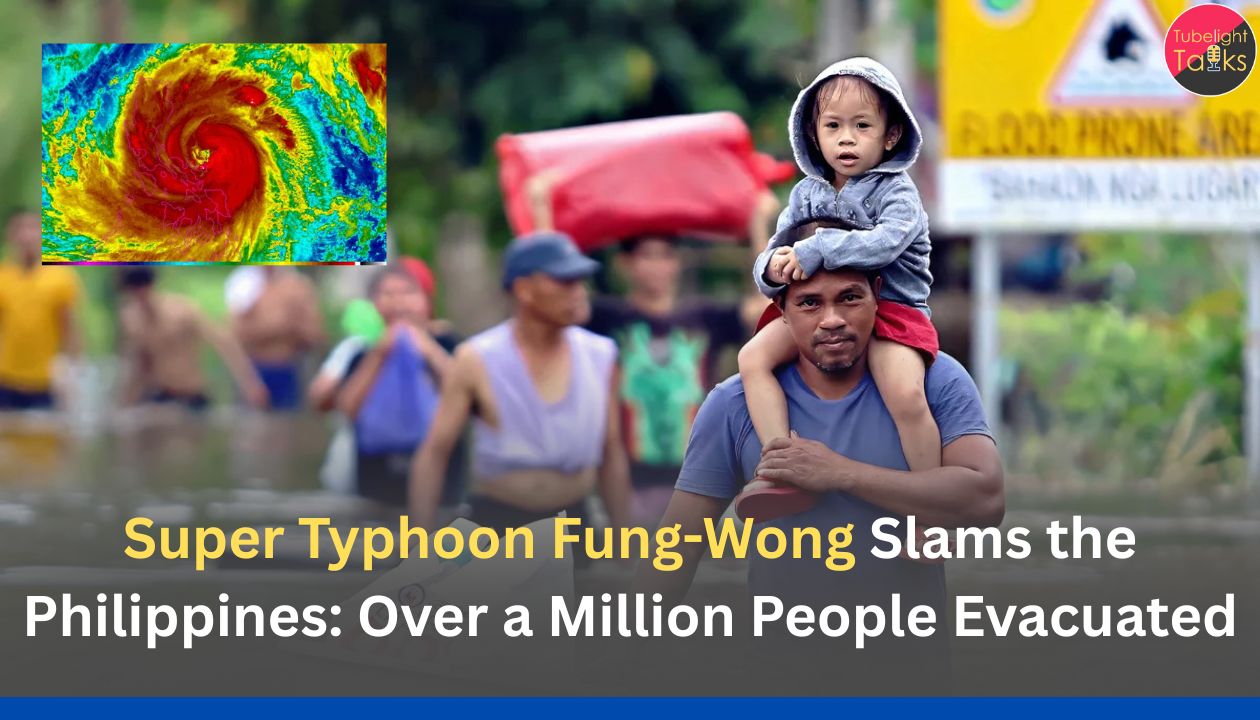Super Typhoon Fung Wong: The Philippines is facing one of the most powerful storms of the year, Super Typhoon Fung-Wong. The storm made landfall on Friday night, bringing with it violent winds, heavy rainfall, and massive flooding across several regions of the country.
According to local reports, more than one million people have been evacuated from coastal and low-lying areas as a safety measure. Despite these efforts, at least two people have lost their lives, and several others have been injured due to falling trees, landslides, and collapsing houses.
Winds stronger than 200 km/h
Super Typhoon Fung-Wong is packing winds of over 200 kilometers per hour, making it one of the most intense storms to hit the Philippines in recent years. The storm has uprooted trees, damaged power lines, and cut electricity in several provinces. Communication networks have also been affected in many areas, making rescue operations difficult.
The Philippine Atmospheric, Geophysical and Astronomical Services Administration (PAGASA) has issued the highest level of storm warning in several regions. Schools, government offices, and airports have been closed. Many flights and ferry services have been cancelled to prevent accidents.
Major cities underwater
The capital city, Manila, and surrounding areas are experiencing heavy rainfall leading to flash floods. Roads have turned into rivers, and thousands of houses have been submerged in water. Videos circulating on social media show people wading through chest-deep water carrying small children and belongings.
Emergency teams and volunteers are working day and night to help people trapped in flooded homes. The government has set up temporary evacuation centers in schools and community halls to shelter displaced families.
International support and aid
Neighboring countries and international organizations have started extending help. Relief agencies like the Red Cross and UNICEF are providing food, water, and medical supplies. Several countries have expressed solidarity with the Philippines and offered emergency assistance.
The Prime Minister of Japan and other world leaders have sent messages of support, promising aid for rehabilitation and rebuilding once the typhoon passes.
A reminder of climate challenges
This disaster again highlights the growing impact of climate change in Southeast Asia. Scientists say that warmer ocean temperatures are making storms like Fung-Wong more powerful and unpredictable. The Philippines, being an island nation, is among the most vulnerable to such extreme weather events.

Environmental experts are urging world governments to take faster climate action and support developing nations in building stronger disaster management systems.
Impact beyond borders
Although the storm hit the Philippines directly, other nearby countries including Taiwan, Vietnam, and southern China are also on high alert. Meteorologists are closely tracking the storm’s movement as it travels northwest over the next few days. India’s weather department has also noted that regional weather patterns may be affected, leading to possible rainfall in the eastern parts of the Indian subcontinent.
Read Also: Philippines Issues Typhoon Warning as Fung-Wong Nears Super Typhoon Strength
Hope amid destruction
Even with the massive damage, the spirit of unity among the Filipino people remains strong. Volunteers are helping distribute relief material and rescue stranded families. Social media is filled with messages of courage and prayers for safety.
As the typhoon slowly moves away, authorities are beginning to assess the total damage to homes, crops, and infrastructure. It may take weeks to restore normal life in many affected areas, but the people of the Philippines are determined to rebuild stronger.
Sant Rampal Ji Maharaj Ji’s humanitarian message
Bandi Chhod Sant Rampal Ji Maharaj Ji always inspires humanity to stand with those in need. His teachings emphasize that true worship includes compassion and service to others. Following His guidance, thousands of followers regularly take part in social welfare works, from helping flood victims and arranging food drives to supporting disaster-hit families. Sant Rampal Ji Maharaj Ji teaches that serving others selflessly brings true peace and earns the blessings of the Supreme God (Satpurush).
In Short:
- Over 1 million evacuated
- At least 2 deaths reported
- Winds above 200 km/h
- Major flooding and power outages
- Global aid and support underway
FAQs on Super Typhoon Fung Wong
1. What is Super Typhoon Fung-Wong?
Super Typhoon Fung-Wong is a powerful tropical cyclone that struck the Philippines with wind speeds exceeding 200 km/h, causing massive flooding and destruction.
2. Which areas are most affected by the typhoon?
Coastal provinces, central and northern Philippines, and the capital city Manila are among the worst affected areas, facing floods and power cuts.
3. How many people have been evacuated?
More than one million people have been moved to safer locations as a precautionary measure by the government.
4. How many deaths have been reported so far?
At least two deaths have been confirmed, and several injuries have been reported due to falling debris and landslides.
5. What actions are being taken for relief and rescue?
Rescue teams, the Red Cross, and government agencies are providing food, shelter, and medical help. International organizations are also sending aid.
6. Is this typhoon connected to climate change?
Experts say that rising ocean temperatures due to climate change are making storms like Fung-Wong stronger and more unpredictable.
7. Can the storm affect India or nearby regions?
While the typhoon is mainly centered over the Philippines, it may indirectly affect weather patterns in Southeast Asia, possibly bringing rain to eastern parts of India.
8. What lessons can be learned from this disaster?
The event shows the importance of early evacuation, strong infrastructure, and global cooperation to face natural disasters intensified by climate change.










